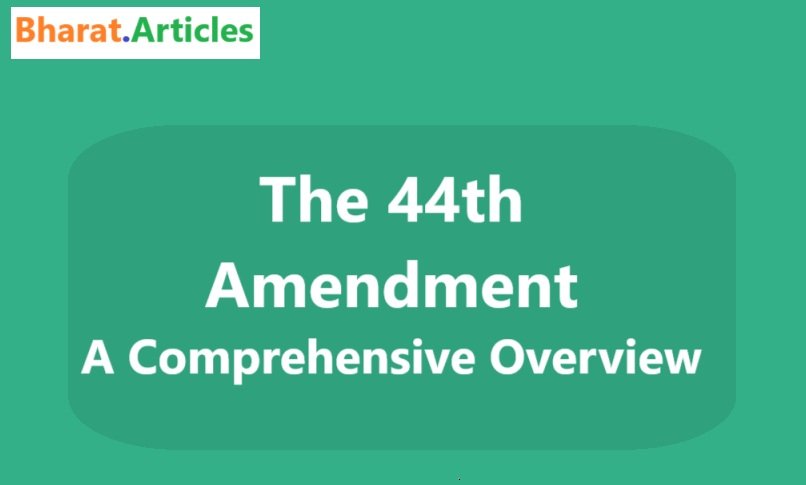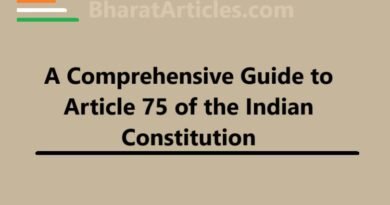
The 44th Amendment: A Comprehensive Overview
The 44th Amendment of the Indian Constitution, passed in 1978, is a significant corrective measure aimed at restoring the constitutional balance that was altered during the Emergency period, especially by the 42nd Amendment. The 42nd Amendment (passed in 1976) had drastically increased the power of the central government, curbed the powers of the judiciary, and eroded the protection of fundamental rights. The 44th Amendment sought to reverse many of these changes and restore the democratic structure and the principles of federalism, which were under threat during the Emergency.
This article explores the provisions of the 44th Amendment, its rationale, and its impact on India’s constitutional framework.
Historical Context of the 44th Amendment
The Emergency declared by Prime Minister Indira Gandhi in 1975, which lasted until 1977, was a period marked by political repression, curtailment of civil liberties, and a centralization of power in the hands of the executive. During this period, the 42nd Amendment was passed, which made significant alterations to the Indian Constitution. The 42nd Amendment was controversial because it limited judicial review, altered the balance of power between the central government and states, and reduced the protection of fundamental rights.
After the Emergency ended and the Janata Party came to power in 1977, there was a realization that the constitutional changes made during this period were undemocratic and authoritarian. This led to the drafting of the 44th Amendment, which sought to restore the balance of power and reinstate fundamental rights and judicial independence.
The 44th Amendment was passed by the Parliament in 1978, under the leadership of Prime Minister Morarji Desai. It aimed to undo many of the provisions of the 42nd Amendment, which had been viewed as detrimental to the democratic principles on which India was founded.
Key Provisions of the 44th Amendment
The 44th Amendment made several important changes to the Constitution, which can be categorized as follows:
1. Restoration of Fundamental Rights
One of the most significant features of the 42nd Amendment was the suspension of certain fundamental rights during the Emergency. The 44th Amendment sought to restore the fundamental rights of the citizens, particularly the right to move the courts for the enforcement of fundamental rights.
- Article 21 (Right to Life and Personal Liberty): The 42nd Amendment had made it easier for the government to curtail fundamental rights during an Emergency. The 44th Amendment sought to ensure that the right to life and personal liberty under Article 21 could not be suspended except during a national emergency.
- Article 21(4): The amendment emphasized that the right to move the court to challenge detention could not be suspended during an emergency.
- Protection Against Preventive Detention: The 44th Amendment sought to limit the power of preventive detention by restricting its duration to three months without obtaining the opinion of an Advisory Board. This measure was aimed at preventing the misuse of preventive detention laws, which had been widely criticized for being used to suppress political dissent during the Emergency.
2. Restoration of Judicial Review
The 42nd Amendment had restricted the powers of the judiciary, particularly in relation to judicial review of constitutional amendments. The 44th Amendment sought to restore the judiciary’s ability to perform its role as a check on the powers of the executive and legislature.
- Reinstatement of Judicial Review: The 44th Amendment made it clear that constitutional amendments, especially those related to fundamental rights, could be subject to judicial review. The amendment reaffirmed that the judiciary could scrutinize laws and executive actions to ensure they comply with the Constitution.
- Article 368 (Amendment Procedure): The 44th Amendment restored the power of judicial review concerning constitutional amendments, a provision that had been curtailed under the 42nd Amendment. It emphasized that amendments affecting fundamental rights could be reviewed by the courts.
3. Reinforcement of Federalism
One of the main objectives of the 44th Amendment was to restore the balance of power between the central and state governments, which had been tilted in favor of the central government by the 42nd Amendment.
- Restoration of the Federal Structure: The 44th Amendment sought to re-establish the federal nature of India’s political system. It reversed the provisions that had concentrated too much power in the central government, as outlined by the 42nd Amendment.
- Article 356 (President’s Rule): The 44th Amendment made changes to the use of President’s Rule in states. It sought to limit the arbitrary imposition of President’s Rule, which had been used excessively during the Emergency. The amendment required that the President’s Rule should be imposed only when the state government fails to function according to the provisions of the Constitution.
4. Limiting the Scope of Emergency Powers
The 42nd Amendment had made sweeping changes to the powers of the government during a state of Emergency. It had made it easier to declare an Emergency, and curbed the protection of fundamental rights during such times. The 44th Amendment sought to limit the scope of these powers and prevent their abuse.
- Article 352 (National Emergency): The 44th Amendment sought to reduce the grounds for the imposition of a national emergency. It clarified that a national emergency could only be declared if there is a threat to the sovereignty, integrity, or security of India due to war, external aggression, or armed rebellion. It restricted the power of the President to declare a national emergency, ensuring that such a decision could not be taken arbitrarily.
- Emergency and Fundamental Rights: The 44th Amendment ensured that during a national emergency, the suspension of fundamental rights would be limited. The amendment specifically provided that the right to life and personal liberty could only be suspended in cases of national emergency, and only by a proclamation made by the President.
5. Reaffirmation of Secularism and Democracy
The 44th Amendment restored the provisions related to secularism and democracy that had been altered by the 42nd Amendment. The 42nd Amendment had inserted the word “socialist” and “secular” into the Preamble, but it had done so in a way that was seen as more ideological than reflective of India’s democratic values.
- Preamble: The 44th Amendment reaffirmed India’s commitment to secularism and democracy, ensuring that the country remained true to its foundational principles.
Impact of the 44th Amendment
The 44th Amendment played a critical role in restoring India’s democratic framework after the authoritarian excesses of the Emergency. Some of the most important outcomes of the 44th Amendment include:
- Restoration of Civil Liberties: The 44th Amendment ensured that the civil liberties of citizens were no longer subject to arbitrary restrictions by the executive. The amendment reinstated the right to move the courts for the enforcement of fundamental rights and curtailed the powers of preventive detention.
- Strengthening Judicial Review: The restoration of judicial review and the independence of the judiciary was one of the most significant outcomes of the 44th Amendment. The judiciary was once again empowered to protect citizens’ rights and ensure that the executive and legislature did not exceed their constitutional limits.
- Reassertion of Federalism: The 44th Amendment rebalanced the power between the central and state governments, ensuring that the states retained their autonomy within the framework of the Constitution. This was an important step in preserving India’s federal structure.
- Safeguarding Democracy: By limiting the scope of emergency powers, the 44th Amendment ensured that future governments could not misuse emergency provisions to rule arbitrarily. It reinforced the democratic process and safeguarded the rights of citizens against authoritarian rule.
Conclusion
The 44th Amendment of the Indian Constitution was a landmark development in the restoration of constitutional balance following the excesses of the Emergency period. It sought to reverse many of the provisions introduced by the 42nd Amendment, restoring fundamental rights, judicial independence, and federalism. The 44th Amendment helped reinforce the democratic fabric of India by ensuring that the central government did not have unchecked powers, and by ensuring that the judiciary could continue to act as a guardian of the Constitution. It remains a crucial amendment in Indian constitutional history, shaping the political and legal landscape for years to come.







Pingback: The 42nd Amendment: A Comprehensive Overview - Bharat Articles